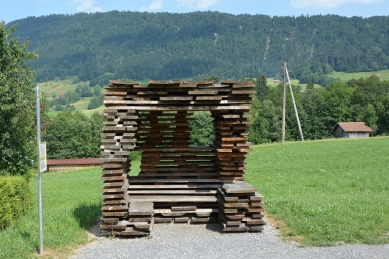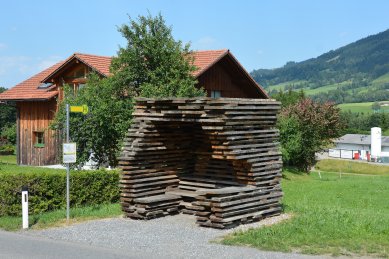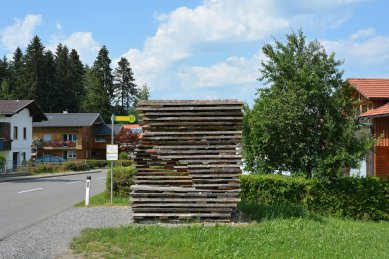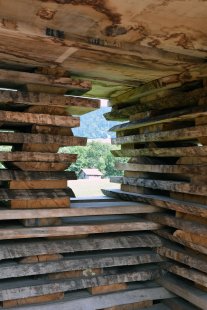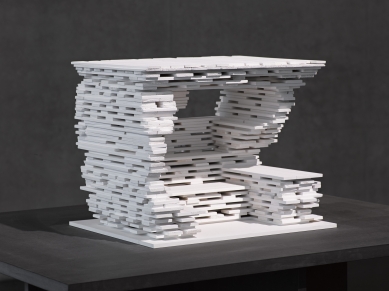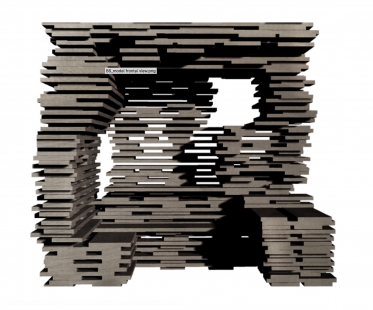
Bus:Stop. Krumbach
Bushaltestelle Unterkrumbach Nord

Bus:Stop is a coral project developed by a group of international and local architects in close collaboration with Krumbach municipal government all engaged in the same mission, to serve the local community and stimulate public transportation in the area.
The brief was to create one of seven bus stops to replace preexisting ones, a shelter for people to wait, with a footprint of 6 m2 maximum and no energy demands. We were given some creative freedom but were insisted to work with materials from the place so that neighbor craftsmen could be involved in the construction process. The visit to the place was key for the development of the project and our engagement. And the idea of the realized project came directly from our impressions from that visit. We decided to work with wood -oak- as one of the most available materials, and appropriated a local technique of stacking planks we found in the drying barns, translating it into an architectural space. Thus we were able to claim the beauty and mechanical logic of everyday structures and to create strong connections with landscape. This is actually the first project we build with wood and we decided to approach the material the same way we have done when building with stone, steel or concrete: going to the origin of the industrial process to understand the possibilities of the material and maximize its expressiveness and performance. The result is a mono-material structure built with oak in one of its earlier stages of manipulation, this is, roughly cut planks. The way these planks are stacked resolve the structure, façade, roof, openings, seating areas and also the water drainage, minimizing the use of other materials and resources used to build the bus stop. A single assembly detail defines a low-res construction process that can crystallize in many forms, and this was important to understand the construction process as a performance in which local craftsmen, acknowledging some basic constructive and spatial guidelines, could work with the necessary improvisation.
In this small architecture, art and science meet in a strong and didactic way. It is a space for the people to use their own way, to interpret, to experience. And we are very curious to learn about its life in Krumbach.
The brief was to create one of seven bus stops to replace preexisting ones, a shelter for people to wait, with a footprint of 6 m2 maximum and no energy demands. We were given some creative freedom but were insisted to work with materials from the place so that neighbor craftsmen could be involved in the construction process. The visit to the place was key for the development of the project and our engagement. And the idea of the realized project came directly from our impressions from that visit. We decided to work with wood -oak- as one of the most available materials, and appropriated a local technique of stacking planks we found in the drying barns, translating it into an architectural space. Thus we were able to claim the beauty and mechanical logic of everyday structures and to create strong connections with landscape. This is actually the first project we build with wood and we decided to approach the material the same way we have done when building with stone, steel or concrete: going to the origin of the industrial process to understand the possibilities of the material and maximize its expressiveness and performance. The result is a mono-material structure built with oak in one of its earlier stages of manipulation, this is, roughly cut planks. The way these planks are stacked resolve the structure, façade, roof, openings, seating areas and also the water drainage, minimizing the use of other materials and resources used to build the bus stop. A single assembly detail defines a low-res construction process that can crystallize in many forms, and this was important to understand the construction process as a performance in which local craftsmen, acknowledging some basic constructive and spatial guidelines, could work with the necessary improvisation.
In this small architecture, art and science meet in a strong and didactic way. It is a space for the people to use their own way, to interpret, to experience. And we are very curious to learn about its life in Krumbach.
0 comments
add comment


